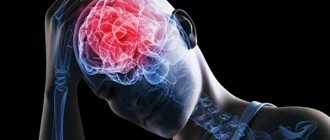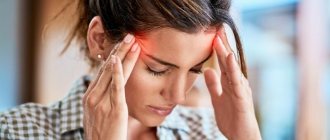First aid for fainting
It is necessary to make sure that the person is breathing. You need to tilt the person’s head back and pay attention to whether the chest is moving, feel the pulse on the carotid artery, and place your palms on your mouth. In order to improve blood circulation, you need to elevate the patient's legs. It is advisable to turn your head to the side so that in case of vomiting, aspiration does not occur. If a person is unconscious, bring ammonia under his nose.
Important: do not use the entire bottle, it is better to apply a few drops on a cotton swab. Otherwise, you can get burned, and in children you can even stop breathing. If ammonia is not available, you need to press on the painful point between the nose and upper lip.
There is no need to panic and do not overdo it in providing assistance.
Symptoms
It is important to know the symptoms of fainting in order to provide first aid in time.
Loss of consciousness, even short-term, is dangerous because it contributes to injury to a person. Fainting causes a traffic accident or leads to fractures, abrasions, and wounds. There are three main stages:
- pre-fainting state,
- fainting,
- post-syncope period.
Fainting usually begins with a pre-fainting state. It occurs differently depending on the age and health status of the person. The approach of fainting begins with a feeling of discomfort, clouding, dizziness, tinnitus, darkening of the eyes, and weakness. The patient then loses consciousness. At the same time, it slowly falls down and “rolls down” the wall. His skin becomes pale and sticky sweat appears.
The pulse is slow and difficult to detect, and the blood pressure is below normal. Breathing becomes rare and shallow. When fainting, the episode of loss of consciousness is short-term, no more than 1 minute. Weakness may persist for an hour.
What should you do after fainting?
If fainting lasts less than 5 minutes and does not have additional symptoms, then there is no need to worry. You just need to rest for your body to recover.
what to do after fainting
But there are indications that require immediate consultation with a doctor:
- If you hit your head when you fall.
- 2 or more fainting episodes per month.
- A pregnant woman or a person with any cardiovascular diagnosis lost consciousness.
Only a doctor will be able to determine whether there is cause for concern and, if necessary, prescribe additional examination.
What to do if you lose consciousness
As was said, fainting rarely occurs suddenly; as a rule, it is preceded by a number of symptoms (presyncope). A person can reduce the likelihood of losing consciousness by taking proper steps during the pre-syncope period.
In this case, it is critical to take a sitting or lying position. In this case, the risk of fainting will be practically zero. The fact is that fainting is possible only in those people who are standing or walking. Therefore, at the slightest sign of impending fainting (nausea, darkening of the eyes, dizziness), you need to find a place and take a horizontal position.
In some cases, it is impossible to follow these recommendations - there is simply no place nearby to lie down. In this case, you need to at least lean against the wall. You can then try to prevent accidental loss of consciousness. To do this, you need to cross your legs, and try to tense your hips and buttocks. This will increase the flow of circulating blood.
Why might fainting happen?
The cause of fainting is a lack of oxygen for optimal functioning of the brain. Reasons for this condition:
- Sudden change in body position. If you sit or lie down for a long time and then quickly get up, your heart may simply not have time to pump blood to your head.
- Blood loss. Due to injury, hemorrhage, internal bleeding.
- Dehydration.
- Intoxication. Moreover, they have completely different etiologies: alcoholic, infectious, food.
- Endocrine dysfunction: thyroid pathology, diabetes mellitus.
- Starvation. Due to lack of nutrients, the production of red blood cells and hemoglobin in it is reduced. As a result, a drop in blood pressure.
- Decreased oxygen supply to the brain.
- Diseases of the cardiovascular system.
Often completely harmless situations lead to fainting, but sometimes there are serious health problems.
Fainting (syncope)
Vasovagal syncope
- the most common type of syncope. Its pathogenetic mechanism consists of sharp peripheral vasodilation. The trigger for an attack can be prolonged standing, staying in a stuffy place, overheating (in a bathhouse, on the beach), excessive emotional reaction, pain impulse, etc. Vasovagal syncope develops only in an upright state. If the patient manages to lie down or sit down, or leave a stuffy or hot room, then fainting may end in the presyncope stage. The vasovagal type of syncope is characterized by pronounced stages. The first stage lasts up to 3 minutes, during which patients manage to tell others that they “feel bad.” The stage of fainting itself lasts 1-2 minutes and is accompanied by hyperhidrosis, pallor, muscle hypotension, a drop in blood pressure with a thread-like pulse at a normal heart rate. In the post-syncope stage (from 5 minutes to 1 hour), weakness comes to the fore.
Cerebrovascular syncope
often occurs with pathology of the spine in the cervical region (spondyloarthrosis, osteochondrosis, spondylosis). The pathognomonic trigger for this type of syncope is sudden turning of the head. The resulting compression of the vertebral artery leads to sudden cerebral ischemia, leading to loss of consciousness. At the presyncope stage, photopsia, tinnitus, and sometimes intense cephalgia are possible. Fainting itself is characterized by a sharp weakening of postural tone, which persists in the postsyncopal stage.
Irritative fainting develops as a consequence of reflex bradycardia when the vagus nerve is irritated by impulses from its receptor zones. The appearance of such fainting can be observed with achalasia cardia, peptic ulcer of the 12th colon, hyperkinesia of the biliary tract and other diseases accompanied by the formation of abnormal visceral reflexes. Each type of irritative syncope has its own trigger, for example, a specific attack of pain, swallowing, or gastroscopy. This type of syncope is characterized by a short, just a few seconds, period of warning signs. Consciousness turns off for 1-2 minutes. There is often no post-syncope period. As a rule, repeated stereotypic fainting is observed.
Cardio- and arrhythmogenic syncope
observed in 13% of patients with myocardial infarction. In such cases, syncope is the first symptom and seriously complicates the diagnosis of the underlying pathology. Features are: occurrence regardless of the person’s position, the presence of symptoms of cardiogenic collapse, great depth of loss of consciousness, repetition of syncopal paroxysm when the patient tries to get up after the first fainting. Syncope, included in the clinical picture of Morgagni–Edams–Stokes syndrome, is characterized by the absence of precursors, the inability to determine the pulse and heartbeat, pallor, reaching the point of cyanosis, and the beginning of the recovery of consciousness after the appearance of heart contractions.
Orthostatic syncope
develops only during the transition from a horizontal position to a vertical position. It is observed in hypotensive patients, persons with autonomic dysfunction, elderly and debilitated patients. Typically, such patients indicate repeated cases of dizziness or “fogging” with a sudden change in body position. Often, orthostatic syncope is not a pathological condition and does not require additional treatment.
Clinical manifestations
The preceding symptoms of fainting are felt by a person faster than this destabilization is noticed by others. The general condition is described as painful, nausea appears, vomiting is possible, the sweat glands actively produce secretions, which the patient characterizes as “cold sweat.” There is an inexplicable weakness and the so-called “ringing in the ears” (tinnitus, generation of a nerve signal without a sound source), the effect of “floaters” in the eyes (myodesopsia, opacification of the vitreous body), and the general tone of the leg muscles is disturbed. There is a pallor of the skin (outflow of blood from the capillaries supplying the upper tissues), the skin acquires a gray tint. Blood pulsates in the temple area, heaviness in the occipital region of the head. The frequency of breathing and normal heart rate increases, blood pressure decreases. You may feel a change in body temperature (fever or chills), or want to yawn. Fingers and toes become suddenly numb. If you feel that such symptoms are approaching, you must take a sitting position in order to minimize possible bodily and traumatic brain injuries as a result of a fall.
Content:
- Clinical manifestations
- Accompanying symptoms
- Types of disorder
- Etiology of occurrence
- Diagnosis for various etiologies
- First aid
Treatment with folk remedies
The use of some folk remedies can help reduce the incidence of syncope. However, these methods are not methods of treating the causes of loss of consciousness, but only auxiliary methods to improve the condition.
- Gentian decoction. To prepare a decoction of this herb, you need to take 2 tsp. crushed raw materials and pour 1 tbsp. boiling water Drink half a glass before each meal.
- Burdock compresses. A fresh burdock leaf should be mashed and placed on the solar plexus. The compress helps you come to your senses after fainting.
- Soothing tea. It helps if a person loses consciousness due to dysfunction of the nervous system. To prepare it, you can take mint, lemon balm, St. John's wort, linden in equal proportions, mix the crushed raw materials, and 2 tbsp. l. pour 2 cups boiling water. After 20 minutes, strain and drink 2 times a day, 1 glass.
- Wormwood oil. Grind 25 g of wormwood seeds in a coffee grinder and pour in 100 g of olive oil. After a day, pour into a dark glass jar and store the product in the refrigerator. Take 2 drops 2 times a day (drop onto sugar).
- Infusion of mountain arnica. 3 tbsp. l. Pour dried arnica flowers into a thermos and pour 200 g of boiling water. After an hour, strain and drink with milk 4 times a day, adding 1 tbsp to 100 g of milk. l. infusion.
- Means for normalizing blood circulation. If loss of consciousness does occur, then after this the person should be given a glass of warm tea or chamomile decoction. Coffee or 1 tbsp will also work. l. cognac to normalize blood circulation.
- Massage of special points. In case of fainting, a massage of the points above the upper lip and under the lower lip will help revive the patient. You need to press hard on them, as sharp pain helps improve blood circulation in the brain. You can also rub the skin in the stomach area for this purpose.
- Cold water. It is sprayed on someone who has lost consciousness. This is especially important if the syncope is caused by overheating. It is recommended to cool the extremities. Also, a person who has come to his senses should drink some cold water in small sips.
In children
If a child faints, the causes of this phenomenon may be associated with both diseases and age-related changes. Most often, syncope manifests itself in a teenager, since during this period the process of puberty actively occurs, which leads to changes in the body. As experts who study syncope in children note, girls are more susceptible to fainting. Most often, such manifestations are observed in children aged 10-12 years. Young children lose consciousness very rarely.
Despite the fact that this phenomenon may be temporary, if a teenager often faints, the reasons must be determined by a specialist after conducting a study. It is important to find out whether a child who often faints suffers from epilepsy or other serious illnesses. In most cases, we are talking about the reflex nature of such conditions in children. Potential health hazards are reported relatively rarely. But it is still better to consult a doctor and follow his advice.
Types of disorder
There are some types of fainting that directly depend on factors influencing development and origin:
- With a neurogenic nature, a vasodepressor disorder occurs: it occurs in the presence of great emotional stress, aggressive and stressful situations. It most often occurs in cases where a person is afraid of blood.
- Orthostatic: appears due to a sharp change in the stable position of the body, most often when changing position from horizontal to vertical. Fainting can also be caused by uncomfortable shoes or clothing that pinches important arteries and blood vessels. The risk group includes men and women who are unable to control the release of urine during sound sleep, intense coughing, and when removing feces.
- Maladaptive: complete or partial lack of adaptation to external environmental conditions, in the event of a sharp change in the climate familiar to a person.
- In the case of hyperventilation, fainting occurs due to increased, excessive breathing, which ultimately causes spasm of cerebral vessels and hypoxia.
- Somatogenic nature: improper functioning of internal organs, except the brain, is observed. In such cases, a cardiogenic disorder occurs (observed in heart pathologies).
- Anemic: occurs due to a decrease in the normal level of hemoglobin and red blood cells in the blood.
- Hypoglycemic: directly related to the lack of normal amounts of glucose in the blood.
- If the cause is extreme, a hypoxic disorder occurs: the body does not receive enough oxygen, perhaps the atmosphere around is thin.
- Hypovolemic: the fundamental factor is bleeding that exceeds the permissible norm - heavy periods, trauma with significant blood loss, extensive burns on the external skin.
- Intoxication: the result of poisoning or general intoxication of the body.
- Drug-induced: occurs when uncontrolled use of medications that lower blood pressure (is a side effect).
- Hyperbaric: an untrained body experiences difficulties when climbing mountains and is prone to syncope.











